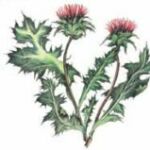| Common Name: |
Blessed Thistle |
| Other Names: |
Holy Thistle, Spotted Thistle, St. Benedict's Thistle. |
| Botanical Name: |
Cnicus benedictus syn. Carbenia benedicta, Carduus benedictus |
| Genus: |
Cnicus |
| Family: |
Asteraceae |
| Native Location: |
Mediterranean regions |
| Cultivation: |
Well-drained soil in sun. |
| Propagation: |
By seed sown in spring. |
| Harvest: |
Plants are cut when flowering and dried for infusions, liquid extracts, and tablets. |
| Height: |
24-65cm (10-26in) |
| Width: |
30cm (12in) |
| Hardiness: |
Hardy |
| Parts Used: |
Flowering tops, Leaves, Upper Stems, Seeds |
| Properties: |
A very bitter, antiseptic, antibiotic herb that acts mainly as a digestive tonic. It is also a mild expectorant, checks bleeding, encourages healing, lowers fever, and stimulates lactation. |
| Medicinal Uses: |
Internally for anorexia, poor appetite associated with depression, dyspepsia, flatulent colic, diarrhea, excess mucus, and insufficient lactation. Excess causes vomiting. Externally for wounds and ulcers. Combines well with Chelone glabra (See, turtlehead) and Cola spp. (See, cola) for anorexia, and with Agrimonia Eupatoria (See, agrimony), Filipendula ulmaria (See, meadowsweet), and Potentilla erecta (See, tormentil) for diarrhea.
To treat fevers, colds, digestive problems, ulcers, and wounds; as a diuretic. Germany's Commission E has approved the used of blessed thistle to treat loss of appetite and dyspeptic complaints such as heartburn and bloating. |
| Typical Dose: |
A typical daily dose of blessed thistle may range from 4 to 6gm of the herb. Tea is prepared by pouring 150ml of boiling water over 1.5 to 2gm of herb, steeping for five to ten minutes, then drinking the tea thirty minutes before a meal. |
| Possible Side Effects: |
Blessed thistle's side effects include stomach irritation and vomiting. |
| Drug Interactions: |
| Taking blessed thistle with these drugs may interfere with the action of the drug: |
| Aluminum Hydroxide, (AlternaGel, Alu-Cap) |
Aluminum Hydroxide and Magnesium Carbonate, (Gaviscon Extra Strength, Gaviscon Liquid) |
Aluminum Hydroxide and Magnesium Hydroxide, (Maalox, Rulox) |
Aluminum Hydroxide and Magnesium Trisilicate, (Gaviscon Tablet) |
| Aluminum Hydroxide, Magnesium Hydroxide, and Simethicone, (Maalox, Mylanta Liquid) |
Calcium Carbonate, (Rolaids Extra Strength, Tums) |
Calcium Carbonate and Magnesium Hydroxide, (Mylanta Gelcaps, Rolaids Extra Strength) |
Cimetidine, (Nu-Cimet, Tagamet) |
| Esomeprazole, (Nexium) |
Famotidine, (Apo-Famotidine, Pepcid) |
Famotidine, Calcium Carbonate, and Magnesium Hydroxide, (Pepcid Complete) |
Lansoprazole, (Prevacid) |
| Magaldrate and Simethicone, (Riopan Plus, Riopan Plus Double Strength) |
Magnesium Hydroxide, (Dulcolax Milk of Magnesia, Phillips' Milk of Magnesia) |
Magnesium Oxide, (Mag-Ox 400, Uro-Mag) |
Magnesium Sulfate, (Epsom Salts) |
| Nizatidine, (Axid, PMS-Nizatidine) |
Omeprazole, (Losec, Prilosec) |
Pantoprazole, (Pantoloc, Protonix) |
Rabeprazole, (Aciphex, Pariet) |
| Ranitidine, (Alti-Ranitidine, Zantac) |
Sodium Bicarbonate, (Brioschi, Neut) |
Sucralfate, (Carafate, Sulcrate) |
|
| Disease Effects: |
May worsen inflammatory or infectious gastrointestinal ailments by irritating the gastrointestinal tract. |
| Supplement Interactions: |
May cause allergic reaction in those sensitive to herbs from the Asteraceae family such as German Chamomile, Daisy, or Dandelion. |
| Warning: |
This herb is subject to legal restrictions in some countries. |
| Bibliography: |
Encyclopedia of herbs by Deni Brown Copyright © 1995, 2001 Dorling Kindersley Limited. pg 174
The Essential Herb-Drug-Vitamin Interaction Guide by Geo. T. Grossberg,MD and Barry Fox,PhD Copyright©2007 Barry Fox,PhD Pp.86-87 |

